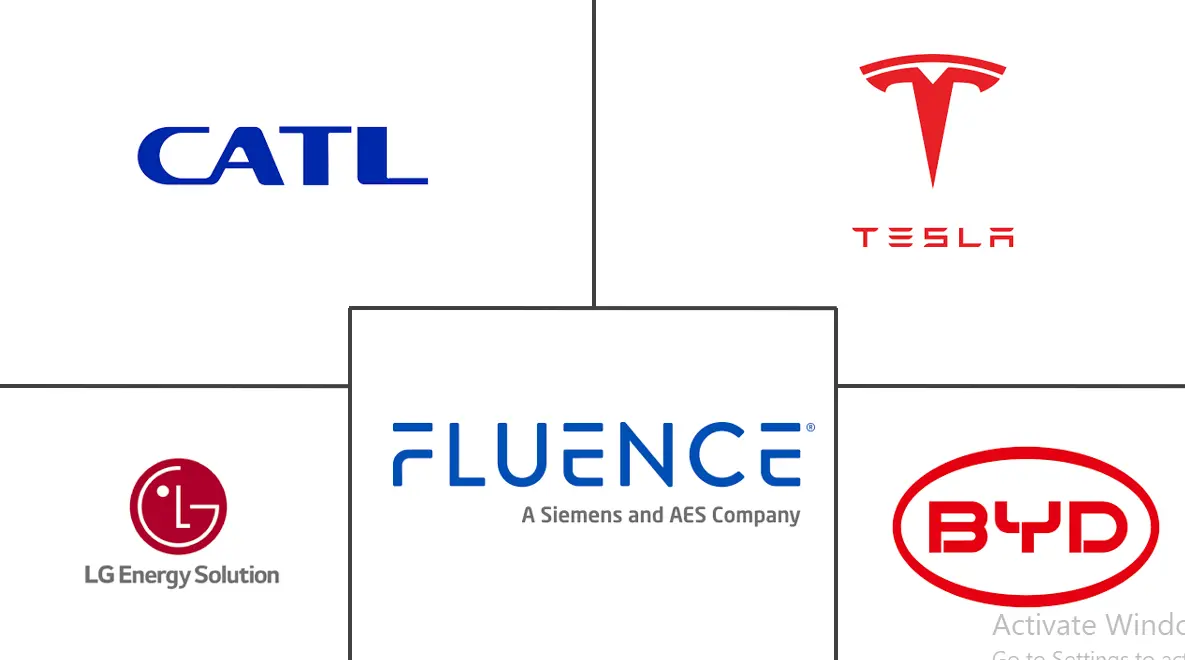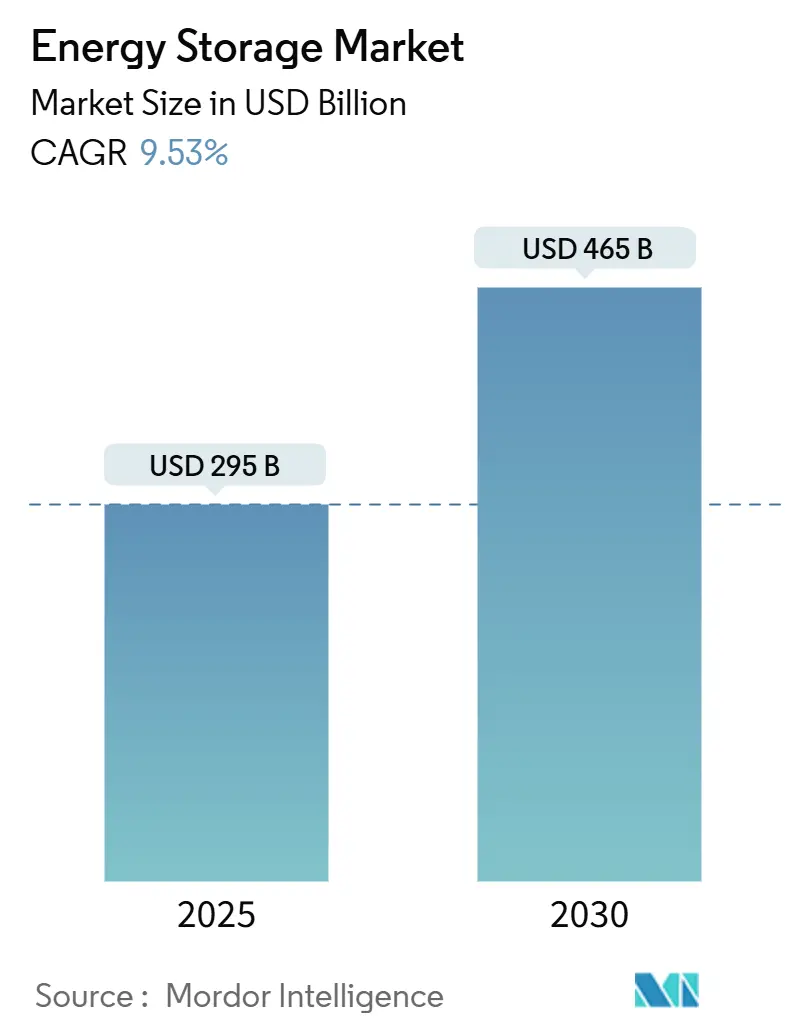
Energy Storage Market Analysis by Mordor Intelligence
The Energy Storage Market size is estimated at USD 295 billion in 2025, and is expected to reach USD 465 billion by 2030, at a CAGR of 9.53% during the forecast period (2025-2030).
This scale-up rests on falling battery pack prices, policy incentives that reward standalone storage, and a rising need for flexible capacity as solar and wind portfolios expand. Rapid cost declines in lithium-iron-phosphate (LFP) technology, the pivot to >6-hour battery energy storage systems (BESS), and the accelerating electrification of transport all reinforce the current growth trajectory. Competitive dynamics are equally fluid: Chinese suppliers are pursuing cost leadership and global contracts, while North American and European integrators emphasize software, grid-forming controls, and safety compliance. Longer-duration technologies—thermal, gravity, and flow batteries—are beginning to complement lithium-ion in markets that prize multi-hour dispatchability and low lifetime cost.
Key Report Takeaways
- By geography, Asia-Pacific led with 43% of the energy storage market share in 2024, whereas North America is expected to post the fastest 14.5% CAGR through 2030.
- By technology, pumped-storage hydroelectricity accounted for 84% of 2024 revenue; battery systems are forecast to expand at a 16.5% CAGR between 2025-2030.
- By connectivity, on-grid systems commanded 90% share of the energy storage market size in 2024, but off-grid deployments are advancing at a 12.3% CAGR to 2030.
- By application, grid-scale utility projects captured 64% of the energy storage market size in 2024, while EV-charging and transport solutions are expected to grow at a 16.6% CAGR through 2030.
Global Energy Storage Market Trends and Insights
Drivers Impact Analysis
| Driver | (~) % Impact on CAGR Forecast | Geographic Relevance | Impact Timeline |
|---|---|---|---|
| Rapid LFP battery cost declines | +2.90% | Asia-Pacific, North America, Europe | Medium term (2-4 years) |
| Grid-scale incentive schemes | +2.40% | North America, Europe, China | Medium term (2-4 years) |
| Mandatory GCC renewable-integration targets | +1.40% | Middle East, North Africa | Long term (≥4 years) |
| Data-center power-quality demand | +1.10% | North America, Nordics, Singapore | Short term (≤2 years) |
| EV-charging corridor build-outs | +1.0% | Europe, North America, China | Medium term (2-4 years) |
| Corporate PPA-driven behind-the-meter uptake | +0.8% | Europe, Australia, North America | Short term (≤2 years) |
| Source: Mordor Intelligence | |||
Rapid LFP Battery Cost Declines Driving >6-Hour BESS Adoption
Record lows of USD 115/kWh in 2024 firmly repositioned LFP as the anchor chemistry for long-duration BESS.[1] BloombergNEF, “Battery Pack Prices Fall to USD 115/kWh in 2024,” about.bnef.com With 88% share of 2024 installations, the chemistry’s safety profile is easing permitting and insurance barriers while enabling utilities to displace gas peakers for up to 10 hours of discharge. Chinese oversupply is reinforcing buyer leverage, accelerating multigigawatt procurement rounds in the United States and Europe.
Grid-Scale Incentive Schemes Accelerating Market Transformation
Investment tax credits under the U.S. Inflation Reduction Act (IRA) unlocked 11.9 GW of storage additions in 2024 and a pipeline of 18.2 GW for 2025. Similar momentum stems from the EU Renewable Energy Directive III, which mandates higher renewables penetration, and China’s long-duration storage targets that foster flow-battery innovation. Public grants, such as the California Energy Commission’s USD 270 million program for long-duration pilots, are bridging the gap between lab and commercial scale.
Mandatory GCC Renewable-Integration Targets Boosting Thermal & CAES
Saudi Arabia’s 7.8 GWh BESS award and 2.5 GW/12.5 GWh follow-on contracts support a national strategy to integrate 15 GW of new solar by 2030. Thermal storage and compressed-air energy storage (CAES) suit the region’s hot climate and vast salt caverns, spurring exportable know-how in high-temperature storage designs.
Data-Center Power-Quality Demands Spurring Flywheel & BESS
U.S. data centers could draw 6.7-12% of nationwide electricity by 2028, more than double 2023 levels.[2]U.S. Department of Energy, “Data Center Energy Usage Report,” energy.gov Millisecond-response flywheels paired with batteries are therefore emerging to safeguard uptime in Northern Virginia, Texas, and Nordic hyperscale hubs. Storage vendors are tailoring high power-to-energy ratios and advanced thermal management to this lucrative niche.
Restraints Impact Analysis
| Restraint | (~) % Impact on CAGR Forecast | Geographic Relevance | Impact Timeline |
|---|---|---|---|
| Scarcity of pumped-hydro reservoir sites | -1.9% | Europe, Japan, North America | Long term (≥4 years) |
| Vanadium/zinc electrolyte price swings | -1.40% | Global, led by China | Medium term (2-4 years) |
| Stringent urban BESS fire codes | -1.0% | North America, Europe, Australia | Short term (≤2 years) |
| Revenue-stacking uncertainty in emerging markets | -0.5% | South America, Southeast Asia, Africa | Medium term (2-4 years) |
| Source: Mordor Intelligence | |||
Scarcity of Suitable Reservoir Sites Limiting New Pumped Hydro
Although pumped hydro still stores about 9,000 GWh worldwide, greenfield prospects are scarce in Europe, Japan, and parts of North America. Permitting can exceed 8 years, eroding the technology’s cost advantage. Closed-loop concepts and gravity systems repurposing disused mine shafts, such as Energy Vault’s Sardinia project, aim to keep long-duration options alive but remain unproven at comparable scale.
Fire Safety Regulations Increasing Urban Storage Costs
Standards like NFPA 855 force costly detection, ventilation, and deflagration panels, adding 15-25% to urban BESS capital cost. Several U.S. state bills now mandate layered approvals for projects exceeding 200 MWh, shifting large installations toward ex-urban sites. Developers are responding with lithium-iron-phosphate racks, container-level isolation, and emerging sodium-ion systems t o pass more stringent fire-propagation tests.
Segment Analysis
By Technology: Batteries Challenge Hydropower Dominance
Battery systems delivered USD 49 billion of the energy storage market size in 2024 and are forecast to expand at a 16.5% CAGR through 2030. LFP packs under USD 115/kWh are allowing 8-hour dispatch to compete with conventional pumped hydro for daily arbitrage cycles. Meanwhile, the energy storage market share of pumped-storage hydroelectricity slipped to 84% in 2024 as reservoir-site scarcity, long permitting cycles, and environmental constraints stalled new projects in Europe and Japan.
Thermal, gravity, and flow batteries are gaining traction where multi-day or week-long storage is desired. Iron-air technology, backed by USD 405 million of recent funding, promises 100-hour discharge windows, while zinc-bromine and vanadium flow stacks avoid lithium supply risks. Hybrid topologies are proliferating: gravity or CAES modules supply baseload discharge while batteries handle ancillary services in the first minutes after a grid event.
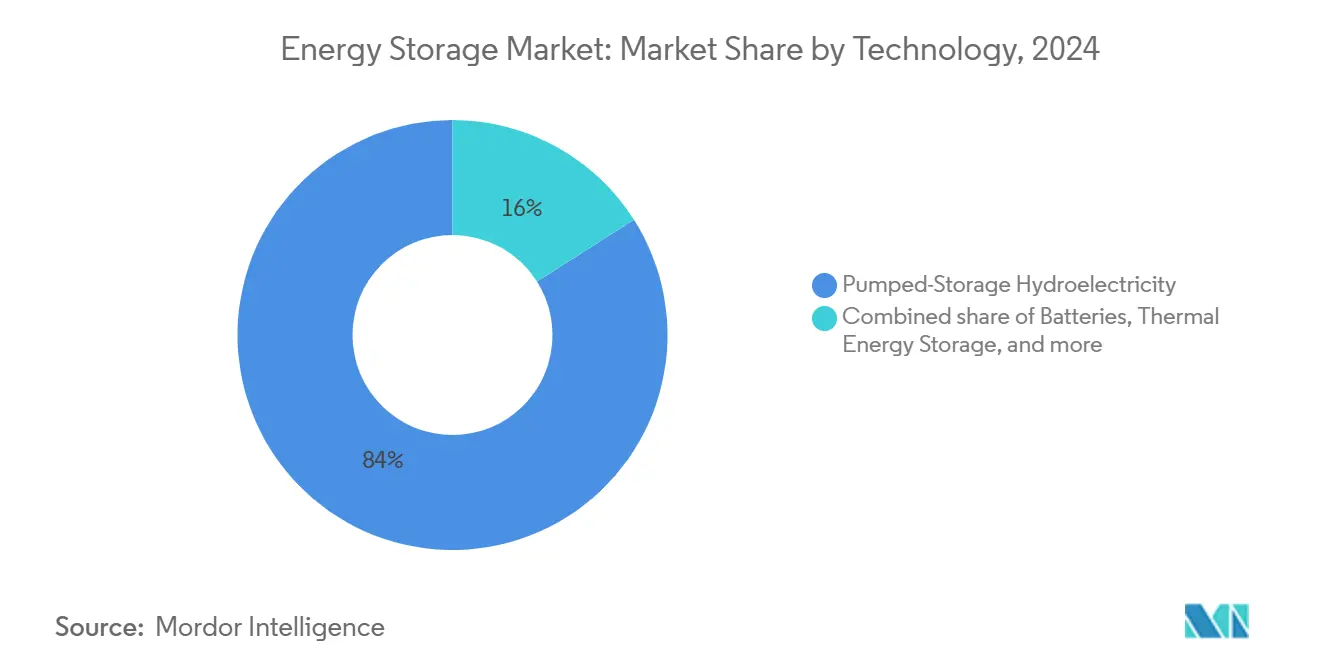
Note: Segment shares of all individual segments available upon report purchase
By Connectivity: Grid Integration Reshapes Energy Markets
On-grid assets accounted for 90% of 2024 revenue, cementing their role in frequency control, reserve markets, and transmission-upgrade deferrals. California’s fleet now supplies up to 15% of evening peak demand, a feat that would have been impossible without advanced grid-forming inverters that provide synthetic inertia.[3]California Public Utilities Commission, “Energy Storage Procurement Tracker,” cpuc.ca.gov Off-grid and microgrid deployments, though only 10% today, are growing at a 12.3% CAGR as remote mines, islands, and rural clinics seek diesel displacement and resilience.
Hybrid systems blur the boundary. Data centers and hospitals commission “islandable” projects that connect normally but detach during grid outages. This versatility broadens the energy storage market, allowing integrators to repurpose software stacks across utility, commercial, and community segments.
By Application: EV Infrastructure Drives New Demand
Grid-scale utility projects commanded 64% of the energy storage market size in 2024, underpinning resource-adequacy obligations. They increasingly co-locate with solar or wind to exploit federal and state incentives while minimizing grid-connection queues. ACEN Australia’s 200 MW/400 MWh New England BESS, equipped with grid-forming controls, exemplifies the trend to integrate stability features once reserved for synchronous machines.
EV-charging and transportation uses are forecast to expand at a 16.6% CAGR through 2030. Battery-buffered ultra-fast chargers limit distribution-system upgrades while capturing demand-charge savings. Fleet depots use stationary packs for load-shifting, managed by V2G software that coordinates depot batteries with onboard vehicle batteries for aggregate market participation. Residential, commercial, and industrial behind-the-meter systems round out the landscape, encouraged by dynamic tariffs and blackout-related resiliency planning.
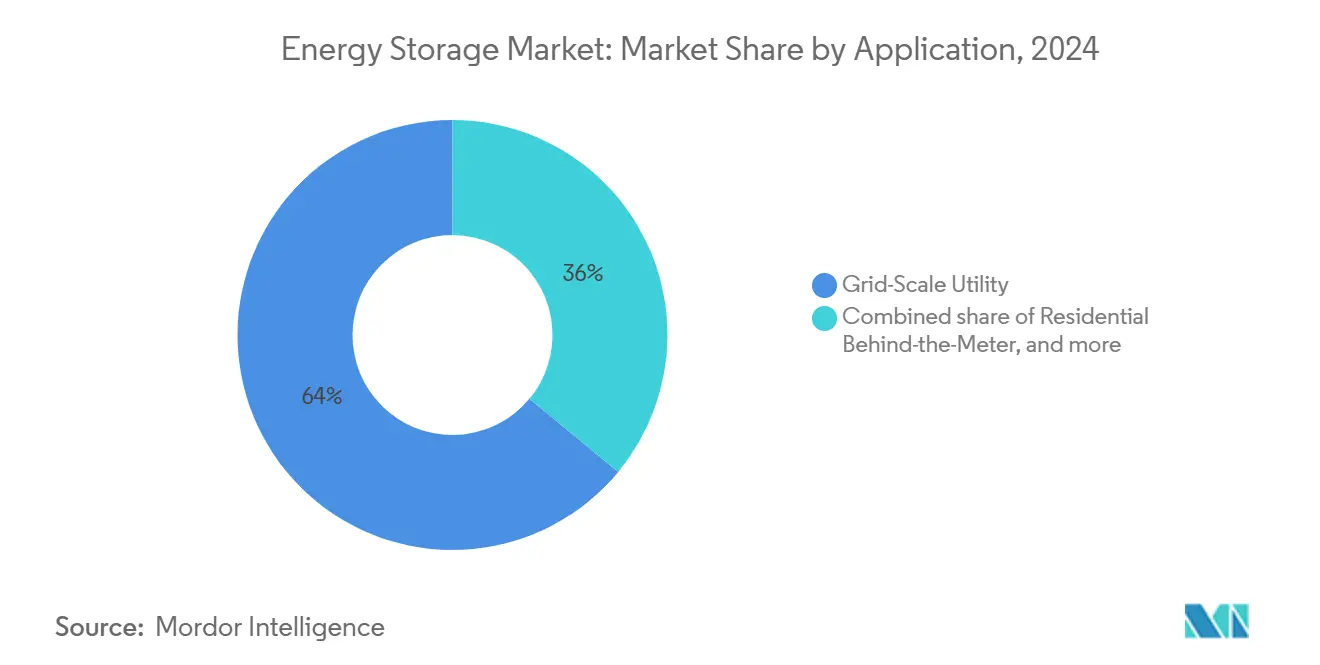
Note: Segment shares of all individual segments available upon report purchase
Geography Analysis
Asia-Pacific retained 43% of 2024 revenue and is central to supply-chain scale-up. China alone installed 81 GWh in 2024—more than the rest of the world combined—bolstered by its 33% renewable-energy share target for 2025.[4] International Energy Agency, “China Renewables Update 2024,” iea.org Australia leads residential adoption as high rooftop-solar penetration and volatile tariffs accelerate payback for paired batteries. India’s first stand-alone utility BESS in 2025 signals an emerging procurement cycle aimed at hybrid renewable parks.
North America is the fastest-growing region at a projected 14.5% CAGR through 2030. The IRA’s direct incentive for stand-alone storage flattened the previous solar-coupling requirement, unleashing gigawatt-scale pipelines centered in California and Texas. The U.S. Energy Information Administration expects batteries to supply 18.2 GW of new utility-scale capacity in 2025, second only to solar additions.[5]U.S. Energy Information Administration, “Solar and Batteries Lead 2025 Capacity Additions,” eia.gov Regional focus on resilience after extreme-weather outages further reinforces demand for microgrids and community-storage schemes.
Europe recorded a 94% y-o-y capacity jump in 2023, reaching 17.2 GWh. Germany dominates with 1.9 GWh of large-scale systems in operation by late-2024, aided by high retail prices and streamlined permitting. The United Kingdom and France trail but have multigigawatt pipelines backed by capacity-market revenue and grid-balancing services. The continent’s shift from residential to utility-scale projects is evident in TotalEnergies’ new 100 MW/200 MWh German site that pairs solar with two-hour storage for intraday smoothing.
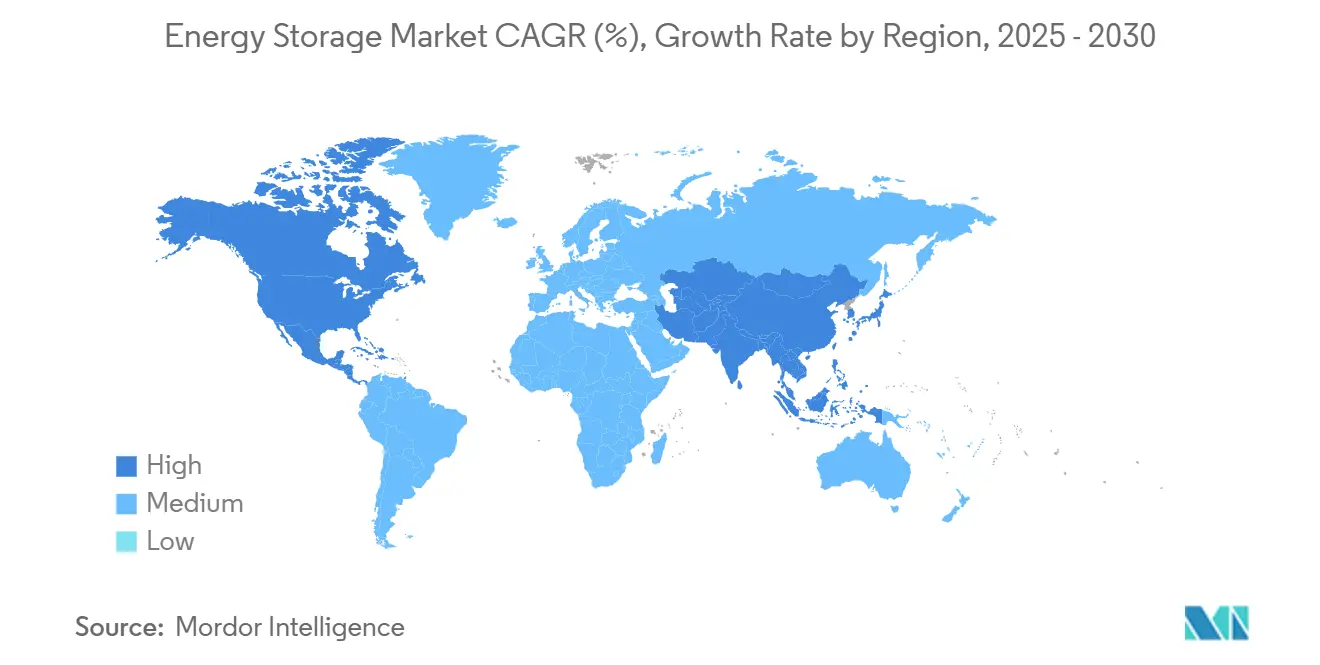
Competitive Landscape
Competition in the energy storage market is intense and multidimensional. CATL leads battery shipments and is using scale to bid aggressively on export contracts such as a 19 GWh UAE order. Tesla combines cell supply with inverter electronics and software, recently winning a record 15.3 GWh BESS deal with Intersect Power. Fluence, Siemens-AES’ joint venture, focuses on grid services and digital analytics but trimmed 2025 guidance after contract delays and margin pressure.
Consolidation is underway as oil-and-gas majors seek entry points. TotalEnergies acquired Kyon Energy to internalize project development and grid-services know-how. In long-duration niches, Energy Vault, Hydrostor, and Form Energy secured Series-C and Series-D rounds exceeding USD 400 million, betting on gravity, compressed-air, and iron-air chemistries, respectively. Software layers that monetize multi-service stacking—frequency response, capacity, and congestion relief—are emerging as critical differentiators now that hardware costs converge.
Energy Storage Industry Leaders
Contemporary Amperex Technology Co. Ltd. (CATL)
Tesla Inc.
LG Energy Solution Ltd.
BYD Co. Ltd.
Fluence Energy Inc.
- *Disclaimer: Major Players sorted in no particular order
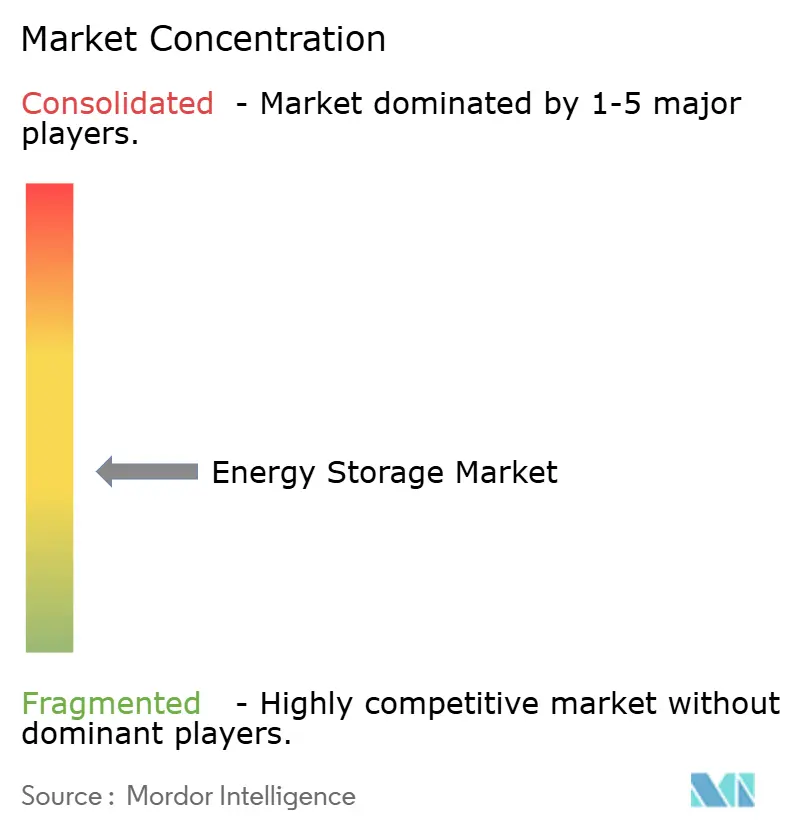
Recent Industry Developments
- May 2025: TotalEnergies launched six German battery storage projects totaling 100 MW/200 MWh, its largest continental deployment yet.
- May 2025: Saudi Electricity Company contracted 2.5 GW/12.5 GWh of BESS to support 15 GW of upcoming solar capacity
- April 2025: EVLO commissioned its first storage project in American Samoa, with two more planned, enhancing island resilience.
- February 2025: ACEN Australia started constructing a 200 MW/2-hour BESS at its New England Solar farm, featuring grid-forming inverters.
Research Methodology Framework and Report Scope
Market Definitions and Key Coverage
Our study defines the global energy-storage market as all new, grid-connected or stand-alone systems that accumulate electrical or mechanical energy for later use, including pumped-storage hydro, electrochemical batteries, compressed or liquid air, thermal media, flywheels, gravity, and hydrogen-based solutions. Value is captured at system commissioning and includes turnkey equipment, EPC services, and integrated software.
Scope Exclusion: mobile traction batteries installed in electric vehicles are outside this analysis.
Segmentation Overview
- By Technology
- Batteries (Lithium-ion, Solid-State Li, Sodium-ion, Lead-acid, Sodium-Sulfur, and Flow Batteries (Vanadium, Zinc-Bromine))
- Pumped-Storage Hydroelectricity
- Thermal Energy Storage (Sensible Heat (Molten Salt, Water), Latent Heat (Phase-Change Materials), Thermochemical)
- Compressed Air Energy Storage
- Liquid Air/Cryogenic Storage
- Flywheel Energy Storage
- Gravity-Based Storage
- Hydrogen-Based Storage (Power-to-H2-to-Power)
- Other Emerging Technologies (Iron-Air, Zinc-Air)
- By Connectivity
- On-Grid
- Off-Grid
- By Application
- Grid-Scale Utility (Front-of-Meter)
- Residential Behind-the-Meter
- Commercial and Industrial Behind-the-Meter
- Data Centers and Critical Facilities
- Remote and Off-Grid/Microgrids
- Others (Transportation and Rail Electrification, EV-Charging Infrastructure, Transmission and Distribution Deferral)
- By Geography
- North America
- United States
- Canada
- Mexico
- Europe
- United Kingdom
- Germany
- France
- Spain
- Nordic Countries
- Russia
- Rest of Europe
- Asia-Pacific
- China
- India
- Japan
- South Korea
- ASEAN Countries
- Rest of Asia-Pacific
- South America
- Brazil
- Argentina
- Colombia
- Rest of South America
- Middle East and Africa
- United Arab Emirates
- Saudi Arabia
- South Africa
- Egypt
- Rest of Middle East and Africa
- North America
Detailed Research Methodology and Data Validation
Primary Research
Our team supplements desk work with interviews and structured surveys involving OEM engineering leads, project developers, utility planners, and finance experts across Asia-Pacific, North America, Europe, and selected emerging hubs. These discussions test preliminary assumptions on average selling prices, installation lead times, duration preferences, and policy risk, letting us fine-tune regional multipliers and technology adoption curves.
Desk Research
We begin by mapping supply, demand, and installed-base fundamentals through respected public sources such as the International Hydropower Association, U.S. Energy Information Administration, Eurostat, China National Energy Administration, and industry bodies like the Long Duration Energy Storage Council. Trade statistics, FERC interconnection queues, patent families (Questel), and public tender archives (Tenders Info) give our analysts early signals on capacity pipelines and price trajectories. Company 10-Ks, prospectuses, and credible press releases flesh out project lists, while news aggregators inside Dow Jones Factiva help us track commissioning milestones and policy shifts day by day. These sources illustrate, but do not exhaust, the many datasets we review before sizing and segmenting the market.
Market-Sizing & Forecasting
A top-down build traces global electricity generation, pumped-hydro additions, and storage-to-generation penetration ratios; these totals are cross-checked through bottom-up samples of supplier revenues, unit shipments, and EPC contract awards. Key variables in the model include lithium-ion pack price per kWh, average duration (hours) by application, renewable curtailment rates, grid-scale policy incentives, and announced pumped-hydro refurbishments. Gaps in bottom-up coverage are bridged with weighted averages from analogous geographies before reconciliation. Multivariate regression on GDP growth, renewable build-out, and battery price learning curves feeds an ARIMA forecast that extends from the 2025 baseline to 2030, with scenario bands reflecting raw-material price volatility.
Data Validation & Update Cycle
Outputs pass a three-layer review: automated variance checks, peer analyst audit, and leadership sign-off. We then benchmark against independent capacity trackers and commodity indexes. Reports refresh yearly, and interim updates trigger when new incentives, safety codes, or GW projects materially alter the outlook.
Why Our Energy Storage Baseline Stands Up to Scrutiny
Published numbers often diverge because firms define storage assets, valuation points, and forecast drivers differently. Our analysts anchor estimates to the complete asset stack (hardware plus EPC) and refresh the baseline every twelve months, limiting vintage risk.
Key gap drivers include whether pumped-storage hydro is counted, how battery system prices are normalized, and the timeliness of policy adjustments such as the U.S. investment tax credit expansion or China's 2-hour minimum rule.
Benchmark comparison
| Market Size | Anonymized source | Primary gap driver |
|---|---|---|
| USD 295 bn (2025) | Mordor Intelligence | - |
| USD 90.36 bn (2024) | Global Consultancy A | Excludes pumped-hydro and long-duration mechanical systems; shorter refresh cadence; currency fixed at 2023 averages |
| USD 50.81 bn (2025) | Industry Journal B | Battery-only scope; relies mainly on supplier announcements without triangulating EPC spend or hydro expansions |
The comparison shows why decision-makers seeking a balanced, transparent view rely on Mordor Intelligence: our broader scope, mixed-method modeling, and disciplined update cycle deliver a dependable baseline that aligns with real-world investment flows.
Key Questions Answered in the Report
What is the projected energy storage market size by 2030?
The energy storage market size is forecast to reach USD 465 billion by 2030, rising from USD 295 billion in 2025.
Which region will grow the fastest in the next five years?
North America is expected to post the quickest expansion, with a 14.5% CAGR from 2025 to 2030, underpinned by U.S. federal tax credits and state-level reliability targets.
Which technology currently commands the largest energy storage market share?
Pumped-storage hydroelectricity still leads with 84% share in 2024, although batteries are growing rapidly and eroding this dominance.
Why are data centers important for the future of energy storage?
Rising AI-driven electricity demand is pushing data centers to install millisecond-response storage for power-quality control, creating a high-value growth segment.
How do fire safety regulations affect urban battery projects?
New standards such as NFPA 855 increase urban BESS costs by up to 25% due to enhanced fire-prevention hardware and permitting requirements, prompting developers to favor safer chemistries or ex-urban sites.
What role do EV-charging corridors play in storage adoption?
Batteries co-located with highway fast-chargers mitigate grid constraints, enable high-power charging without expensive feeder upgrades, and generate additional grid-service revenue streams.
